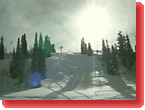J
i m S t e e n b u r g h
 |
|
Jim
Steenburgh
Assistant Professor, Department of Meteorology
University of Utah
CO-Principal Investigator, "IPEX"
|
I
was first turned on to the science of meteorology in the tenth grade
when my father and I were caught in a heavy thunderstorm while backpacking
in the Adirondacks. We were forced to erect a tent for "emergency shelter"
right in the middle of a marsh. After a night of restless sleep in a
soaking wet sleeping bag, I decided that I wanted to avoid similar problems
in the future and decided to become a meteorologist.
 After
graduating from high school in 1985, I attended Penn State University
and received a B.S. in Meteorology in 1989. Although I received an excellent
education, I found myself less and less interested in East Coast meteorology
and more drawn to examining what happens over the complex terrain of
western North America. In many ways, what happens to weather systems
over the mountain west remains one of great questions in our field. After
graduating from high school in 1985, I attended Penn State University
and received a B.S. in Meteorology in 1989. Although I received an excellent
education, I found myself less and less interested in East Coast meteorology
and more drawn to examining what happens over the complex terrain of
western North America. In many ways, what happens to weather systems
over the mountain west remains one of great questions in our field.
In
1989 I moved to Seattle to attend graduate school at the University
of Washington. Seattle was a city alive with culture and outdoor experiences,
and the faculty at the University of Washington challenged and stimulated
me intellectually. I spent the next few years doing two things: graduate
work and outdoor recreation. Being single, I could still burn the candle
at both ends. I skied 50-60 days a winter and spent most of the summer
hiking and backpacking in the Cascades. As an avid skier, the Cascades
were a dream because they receive so much snow and you can pretty much
ski all year long if you're willing to do some climbing in the summer.
My experiences in the mountains only fueled my desire to better understand
and predict mountain weather, so in between outdoor adventures, I'd
be working on projects related to the interaction of cyclones with the
complex terrain of western North America. The work I did with Cliff
Mass as my advisor led to several publications and included an investigation
of the infamous "Inauguration Day Storm" that produced severe winds
and extensive damage over western Oregon and Washington. I was also
able to study how local mountain-driven wind systems lower snow levels
in Cascade Mountain passes, resulting in a unique microclimate that
often results in great ski conditions but which can also cause hazardous
avalanches.
 In
1995 I received my Ph.D. in Atmospheric Sciences and took a faculty
position at the University of Utah. After six years in the Pacific Northwest
I thought I was an expert in mountain meteorology, but the complex terrain
of the Great Basin quickly humbled me. The terrain of northern Utah
is very irregular, steep, and narrow. In some locations, the Wasatch
Mountains rise almost 7,000 vertical feet in 3 miles! And, there's the
Great Salt Lake to complicate weather patterns. It was great to live
minutes from 520 inches of quality Utah snow each year. On the other
hand, predicting when and how much it snowed proved to be a major challenge,
making it more difficult for me to be out there when the powder was
flying. In
1995 I received my Ph.D. in Atmospheric Sciences and took a faculty
position at the University of Utah. After six years in the Pacific Northwest
I thought I was an expert in mountain meteorology, but the complex terrain
of the Great Basin quickly humbled me. The terrain of northern Utah
is very irregular, steep, and narrow. In some locations, the Wasatch
Mountains rise almost 7,000 vertical feet in 3 miles! And, there's the
Great Salt Lake to complicate weather patterns. It was great to live
minutes from 520 inches of quality Utah snow each year. On the other
hand, predicting when and how much it snowed proved to be a major challenge,
making it more difficult for me to be out there when the powder was
flying.
 My
research over the past few years has thus focused on improving the basic
understanding and prediction of weather systems in areas of complex
terrain, with an emphasis on the Great Basin and northern Utah. We've
done a great deal of work on lake-effect snowstorms of the Great Salt
Lake and think we've made major progress in this area. In a collaborative
project with the National Severe Storms Lab, Desert Research Institute,
and the NOAA Air Operations Center, we recently completed a field program
known as IPEX (i.e., the Intermountain Precipitation EXperiment), which
examined winter storms over northern Utah. We hope to use the data collected
during this event to better understand how our local topography influences
snowfall both in the Wasatch Mountains and over the adjoining lowlands,
including Salt Lake City. My
research over the past few years has thus focused on improving the basic
understanding and prediction of weather systems in areas of complex
terrain, with an emphasis on the Great Basin and northern Utah. We've
done a great deal of work on lake-effect snowstorms of the Great Salt
Lake and think we've made major progress in this area. In a collaborative
project with the National Severe Storms Lab, Desert Research Institute,
and the NOAA Air Operations Center, we recently completed a field program
known as IPEX (i.e., the Intermountain Precipitation EXperiment), which
examined winter storms over northern Utah. We hope to use the data collected
during this event to better understand how our local topography influences
snowfall both in the Wasatch Mountains and over the adjoining lowlands,
including Salt Lake City.
|

 After
graduating from high school in 1985, I attended Penn State University
and received a B.S. in Meteorology in 1989. Although I received an excellent
education, I found myself less and less interested in East Coast meteorology
and more drawn to examining what happens over the complex terrain of
western North America. In many ways, what happens to weather systems
over the mountain west remains one of great questions in our field.
After
graduating from high school in 1985, I attended Penn State University
and received a B.S. in Meteorology in 1989. Although I received an excellent
education, I found myself less and less interested in East Coast meteorology
and more drawn to examining what happens over the complex terrain of
western North America. In many ways, what happens to weather systems
over the mountain west remains one of great questions in our field.
 In
1995 I received my Ph.D. in Atmospheric Sciences and took a faculty
position at the University of Utah. After six years in the Pacific Northwest
I thought I was an expert in mountain meteorology, but the complex terrain
of the Great Basin quickly humbled me. The terrain of northern Utah
is very irregular, steep, and narrow. In some locations, the Wasatch
Mountains rise almost 7,000 vertical feet in 3 miles! And, there's the
Great Salt Lake to complicate weather patterns. It was great to live
minutes from 520 inches of quality Utah snow each year. On the other
hand, predicting when and how much it snowed proved to be a major challenge,
making it more difficult for me to be out there when the powder was
flying.
In
1995 I received my Ph.D. in Atmospheric Sciences and took a faculty
position at the University of Utah. After six years in the Pacific Northwest
I thought I was an expert in mountain meteorology, but the complex terrain
of the Great Basin quickly humbled me. The terrain of northern Utah
is very irregular, steep, and narrow. In some locations, the Wasatch
Mountains rise almost 7,000 vertical feet in 3 miles! And, there's the
Great Salt Lake to complicate weather patterns. It was great to live
minutes from 520 inches of quality Utah snow each year. On the other
hand, predicting when and how much it snowed proved to be a major challenge,
making it more difficult for me to be out there when the powder was
flying.
 My
research over the past few years has thus focused on improving the basic
understanding and prediction of weather systems in areas of complex
terrain, with an emphasis on the Great Basin and northern Utah. We've
done a great deal of work on lake-effect snowstorms of the Great Salt
Lake and think we've made major progress in this area. In a collaborative
project with the National Severe Storms Lab, Desert Research Institute,
and the NOAA Air Operations Center, we recently completed a field program
known as IPEX (i.e., the Intermountain Precipitation EXperiment), which
examined winter storms over northern Utah. We hope to use the data collected
during this event to better understand how our local topography influences
snowfall both in the Wasatch Mountains and over the adjoining lowlands,
including Salt Lake City.
My
research over the past few years has thus focused on improving the basic
understanding and prediction of weather systems in areas of complex
terrain, with an emphasis on the Great Basin and northern Utah. We've
done a great deal of work on lake-effect snowstorms of the Great Salt
Lake and think we've made major progress in this area. In a collaborative
project with the National Severe Storms Lab, Desert Research Institute,
and the NOAA Air Operations Center, we recently completed a field program
known as IPEX (i.e., the Intermountain Precipitation EXperiment), which
examined winter storms over northern Utah. We hope to use the data collected
during this event to better understand how our local topography influences
snowfall both in the Wasatch Mountains and over the adjoining lowlands,
including Salt Lake City.